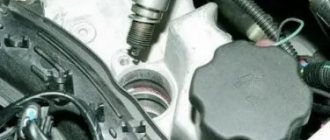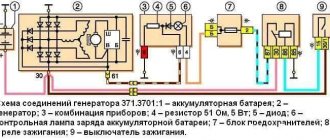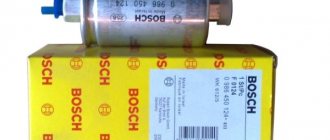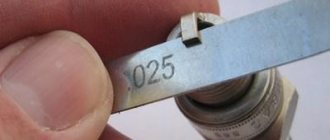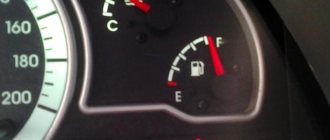Among the common malfunctions of an injection engine or carburetor engine is when the spark is lost on the spark plugs. In this case, the engine may not start or after starting it may function intermittently (triple), since there is no spark at one of the spark plugs and the cylinder actually does not work.
We also recommend reading the article about why the starter turns, but the engine does not start. From this article you will learn about the most common reasons why an engine fails to start when the starter is working normally.
In such a situation, diagnosis should begin with checking the ignition system. In parallel with this, it is worth taking into account certain features and nuances depending on the type of engine installed. Next, we will talk about available ways to check the ignition for spark in relation to engines with a carburetor, and also consider what to do if the spark on an injection engine is lost.
Why the spark disappears: the main reasons
On different types of engines, there is a fairly wide list of reasons why there is no spark at the spark plugs. Among the main experts are:
- Problems with spark plugs (destruction of the spark plug body, defects in the electrodes, etc.). It is also worth noting that the spark plugs may be filled with fuel or oil, which indicates a breakdown of the engine itself.
- Malfunctions of high-voltage wires associated with insulation breakdown or lack of contact.
- Failure or errors in the operation of the crankshaft position sensor.
- Problems with the ignition module, ignition coil, switch;
- Malfunctions or malfunctions of the distributor.
- Deterioration or absence of ground contact.
- Errors related to the operation of the electronic engine control unit (ECU);
Does the starter turn?
First you need to check the voltage in the car's on-board network. To start the machine normally, this indicator should not be lower than 12.5 V. To accurately measure the voltage, you must use a voltmeter. A starter is a mechanism that requires a large starting current. It is this unit that turns the crankshaft for starting. Therefore, if the VAZ-2107 (injector) does not start, the reasons may be trivial - low battery voltage. The solution is to charge the battery. You should stick to 12.5-14 Volts.
No spark on an injection engine or an engine with a carburetor: how to check
Checking the spark is possible using several methods: to ground, using a multimeter, or a special tester on a piezoelectric element. The first method is the simplest. The body of the unscrewed spark plug is brought to the metal (usually the engine cylinder block), after which the engine is cranked by the starter and the presence of a spark is analyzed.
Please note that this verification method cannot be used when diagnosing fuel-injected vehicles. The fact is that a car with an injector has an ECU and other electrical equipment that is quite sensitive and can be damaged.
The second method allows you to better assess the condition of the spark plug, identify breakdown, etc. The use of a special tester is a method of checking the spark on injector cars, reminiscent in its principle of checking by analyzing the spark breakdown to ground (the first method). In this case, the risk of burning the control unit is minimized. Now let's talk about how to check the spark on a fuel-injected engine.
As mentioned above, a special spark arrester device is used to check the spark on the injector. The presence of this solution during diagnostics allows you to accurately localize the problem area, since the ignition spark may not be on the spark plug, on the distributor or on the coil. Also, there may be no spark in only one, several or all cylinders of the engine.
A complete lack of sparking indicates possible problems with the controller, ignition module, coil or center wire. Diagnostics should begin by checking the fuses. Then you should evaluate the condition of the ground contact, and also check the high-voltage wires.
We also recommend reading the article on how to check high-voltage wires yourself. From this article you will learn about ways to diagnose the condition of ignition spark plug wires with your own hands.
If there is no spark at the ignition coil, then the functionality of the high voltage wire should be checked. The specified wire must be checked for insulation integrity, have no breakdowns, burnt areas, etc. Detection of any defects is grounds for its replacement.
Also, in the process of diagnosing the ignition system, you should inspect the spark plugs. This must be done if electricity reaches the candles. On carburetor cars, it is enough to remove the spark plug wire, and then bring it closer to a metal surface (for example, a car body) by half a centimeter. Then you need to turn the starter and make sure that there is a spark running between the wire and the metal surface. The spark itself should also have a certain intensity, be white with a slight bluish tint. If no deviations are noticed, then the spark plugs are working. The reason that there is no spark at the spark plug may be the ignition coil.
If you notice problems with the spark plugs, then you need to pay attention to the spark plug contacts. These contacts must be free of contamination. Let us add that if deviations from the norm are noticed, it is optimal to immediately replace the spark plugs. Failure to do so will indicate the need to clean the contacts.
The old-fashioned way of “revitalizing” a contact
That's usually how it goes. Yesterday the car was fine, it started the first time. In the morning - like “dead”. Any motorist who understands cars will remove the spark plugs, inspect and check them first. No spark.
Further checking is carried out on the coil. It is necessary to inspect the main armored wire to see if current flows through it. No spark again?
Here's what to do:
- Check if current is flowing to the bobbin (coil).
- Check if voltage is going to the switch.
Article on the topic: Technology for replacing a windshield, how long it takes to dry and whether it can be changed in winter
Ignition coil (babin)
If there is voltage, but the spark does not go through the armored wire, the first doubt falls immediately on the woman. She is removed, checked thoroughly, and called. Is she working? It would seem like an opportunity? But this happens often. Don't panic.
And here the distributor itself, the distributor, comes to the fore. It is dismantled, the hall sensor is removed, cleaned of oil (sometimes it gets inside).
As a rule, these actions are enough for a spark to reappear on cars with a non-contact ignition system (non-contact ignition system), where the distributor becomes the “culprit” for the voltage loss. And the reason that the spark has disappeared is either oil getting into the sensor or a loose contact.
This often happens: the wires/communications connecting the switch and distributor provide unreliable, weakened contact. The old “old-fashioned” method of touching everything with your hands is 100 percent effective here. In this way, you can “reanimate”, “revive” the contact.
This method will help you save on the purchase of a coil, hall sensor or switch. It is not uncommon for amateurs in car service centers, who have little understanding of the matter, to send the car owner to the store for parts that are actually in full working order.
Checking the ignition coil for spark
To diagnose the performance of the coil, remove the wire from the distributor-breaker. Next, the test is carried out similarly to testing high-voltage wires, that is, the wire is brought to a metal surface and turned with a starter. The presence of a spark will indicate in this case a problem with the ignition distributor; if there is no spark, then the problem lies in the coil.
First you need to check the distributor contacts. These contacts may oxidize, insulation damage is also possible, and the rotor itself may be faulty. Detecting problems with the rotor allows you to eliminate the problem by replacing it. When checking the ignition coil, you should identify possible defects in the integrity of the winding, burnouts and other signs that a short circuit is occurring inside. If such signs are found, the coil should be replaced or the ignition coil should be repaired.
Let us add that the presence of a spark on the spark plugs does not mean that the car must start. This is especially true for injection engines, where the failure of certain sensors or ECUs can make it very difficult or completely impossible to start the power unit. In such cases, there is a spark, fuel is supplied, but the engine still does not start. The ignition switch also deserves special attention, since malfunctions can occur in this place.
Now let's take a closer look at ways to check the main elements of the ignition system. To do this, let's go back to the coil. As already mentioned, the most common cause of a malfunction is a damaged winding. Then an insulation breakdown occurs and a short circuit occurs. It is also important to understand that the coil can fail due to overload. Such increased loads occur as a result of problematic spark plugs or spark plug wires. For diagnosis you should:
- put the car in a dry parking, repair or other box. You can also use the garage. The main thing is that the humidity is not too high;
- Next, you will need to clean the distributor cover from dirt, after which the specified cover must be removed;
- then you need to turn the engine crankshaft so that the distributor contacts are closed;
- Now you can turn on the ignition and bring the high-voltage wire of the distributor 3-7 mm to ground;
After evaluating the spark, you can decide whether the ignition coil needs to be replaced. Please note that repairing this element is often impractical. Also, when installing a new spare part, you should strictly adhere to the required polarity. If this is not done, then the new part will quickly become unusable after unqualified installation. Please note that car service centers use a special stand to check coils. Such equipment allows you to check the coil taking into account various operating modes.
To check the spark on the spark plugs if the distributor is working properly and there are no problems with the condition of the high-voltage wires, you need to unscrew the spark plugs from the engine. In addition to the contacts, you should look at carbon deposits, the degree of oiling of the electrodes, etc. For normal sparking, contamination must be cleaned. You should also check the gap between the electrodes, which is usually between 0.7 and 0.9 mm. If the gap is broken, then you can carefully bend the side electrode. This method is a temporary measure, but in some cases it allows you to drive from several tens to hundreds of kilometers without tripping the engine in case of problems with the spark plugs.
We also add that there are special pistol devices for checking spark plugs. Typically, such solutions are available from spark plug sellers in car dealerships or automotive markets. If there is such a possibility, then the spark plugs can be checked on similar equipment.
Checking the Low Voltage Circuit Condition
This is also not a superfluous event when it comes to the absence of a spark on the candles. To carry out such a diagnosis, you will need a test lamp. Moreover, choose a device with a power of 2-3 W and a voltage of 12 V.
One contact from the control unit is connected to the low voltage contact of your distributor, and the second goes directly to ground. Now you need to close the distributor contacts and start the ignition. If there are no problems in the circuit, then at the moment the contact closes, the lamp must go out. In this case, it lights up only when the contacts open.
If, after opening the distributor contacts, nothing happened, that is, the control lamp did not light up, the cause of the malfunction most likely lies in the breakdown of the primary winding of the coil, or in the low voltage wires.
There are situations when the control lamp shines constantly during diagnostics, without interruption, regardless of the opening or closing of the contacts. Here you should consider one of several potential reasons for this behavior of the warning light:
- the contacts on the distributor have oxidized, which need to be frequented and, if possible, lubricated with graphite lubricant;
- the wires that connect the movable disk of the distributor and its body are damaged;
- other wiring located between the distributor terminal and the lever was damaged.
The test should always be carried out in stages, starting from the most likely faults, and ending with those that are much less likely to cause a lack of spark.
Do not rush to make the worst and most unpleasant diagnosis for your ignition system. It often happens that the reason lies in banal carbon deposits on spark plugs or blown fuses.
If there is no spark: ignition module
The following symptoms indicate possible problems with the operation of the ignition module:
- at idle speed the engine troits;
- power decreases, the car accelerates poorly;
Engine vibration is most pronounced in two nearby cylinders, and the drop in thrust is more strongly felt during attempts to sharply accelerate the vehicle, that is, when the accelerator is pressed hard and sharply. In such a situation, the “check” light usually lights up on the dashboard of most cars.
If checking the spark plugs and high-voltage wires does not reveal any problems, then the ignition module should be checked with a tester. The test consists of connecting one output of the tester to the module connector, and powering the other to ground. Then the engine can be started. A tester reading of 12 V is evidence that the module is OK. A deviation in the instrument readings from the norm may indicate either the need to replace the module itself or to check/replace the corresponding fuses.
Low Voltage Circuit Diagnostics
For this method, you need to find a test lamp with a power of 2-3 Watts and a voltage of 12V. We connect one contact of the lamp to the low voltage contact of the distributor, and the second to ground.
The next step is to close the contacts of the distributor and turn on the ignition. If there are no problems in the low voltage circuit, the lamp will go out when the contacts are closed and light up when the contacts are open. If opening the contacts does not cause the lamp to glow, the cause of the breakdown is the primary winding of the coil or low voltage wire.
If the lamp glows continuously, regardless of the position of the contacts, this indicates the following possible breakdowns:
- oxidation of distributor contacts;
- damage to the wire connecting the distributor body and its movable disk;
- damage to the wire between the lever and the distributor terminal.
